WebGate WB106X-WG1K WEB SERVER CAMERA User Manual rev V1 1
WebGate Inc. WEB SERVER CAMERA rev V1 1
WebGate >
Users Manual
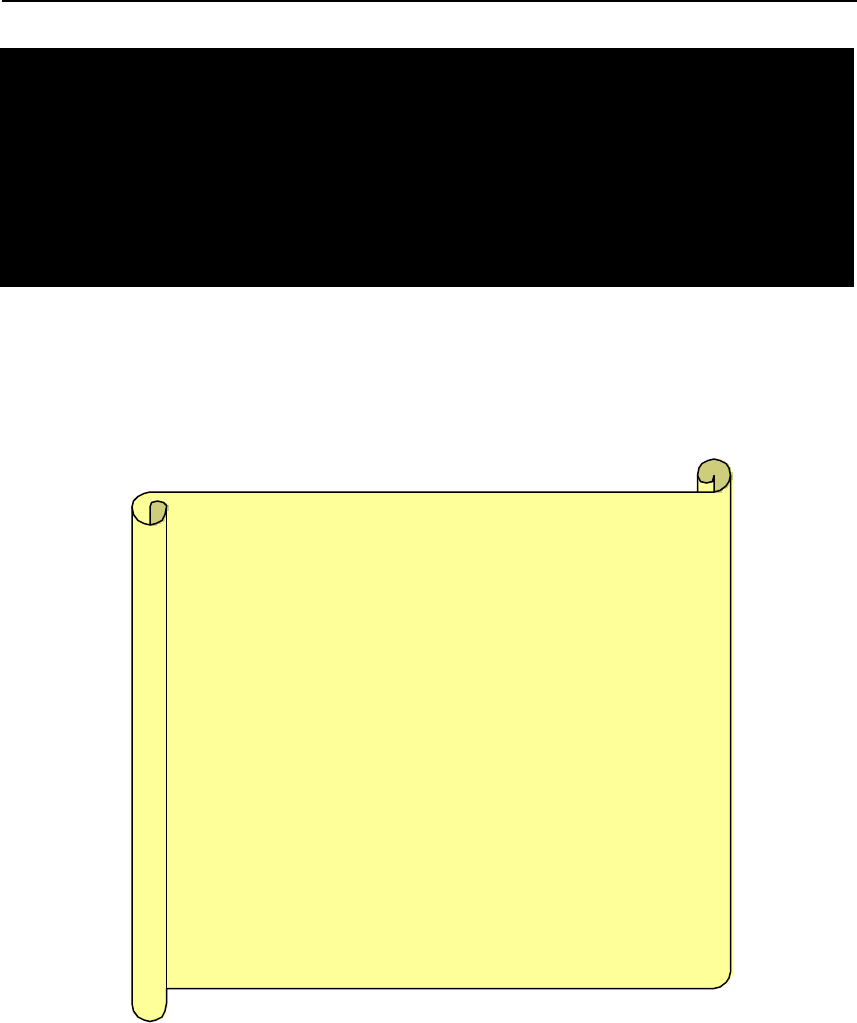
WebEye B106 Manual Ver 1.1
WebEye B106 User’s Guide
* This manual is for WebEye B106 firmware version 1.4.0. If your WebEye has the later
version of firmware, please download the last updated user’s guide from WebGate’s
homepage (www.webgateinc.com)
WebGate Inc.
System Requirements
nn For WebEye
• Network: 10 Base-T LAN
(Leased line, xDSL, Cable Modem, ISDN) or PSTN
nn For a PC to access WebEye
• Processor: Pentium II and above
• RAM: 64MB and more
• OS: Windows 98/NT/2000
• Screen Resolution: 1024 X 768 pixels and above
• Network: 10 Base-T LAN or PSTN
• Web Browser: MS Internet Explorer 5.0 and above
NS Navigator 4.7 and above

WebEye B106WebEye B106
User’s Guide
2
Important Notice
1. WebEye B106 is not weatherproof. Please note the
environmental specifications that are included in the
manual. For outdoor usage, equip a weatherproof case to protect the WebEye B106
from water, moisture,
or extreme temperature changes (higher or lower than the specifications noted below). The WebEye
B106
can be cleaned by gently wiping with a clean dry cloth.
2. Be sure to use the DC adapter that is provided by Web Gate Inc. Connecting WebEye B106 directly to a
n
AC current may cause damage to the WebEye.
3. Be cautious in handling WebEye B106 Physical shock such as dropping the unit may
damage the WebEye
B106 and void warranty.
4 The WebEye B106 is made of aluminum. Be sure that it is fastened tightly during installation
to avoid any
human injuries. Make sure to place away from the reach of children.
5. If WebEye B106 does not operate properly, please contact your WebGate
distributor for after sales
service. Unauthorized personnel are prohibited from disassembling the product. Disassembly
will
automatically result in void of service warranty.
6. Camera surveillance laws may differ for each country and from province to province. C
ontact the local
region representative to avoid any violations and to apply for authorized purposes only.
FCC Compliance Statement
Caution : Any changes or modifications in construction of this device which are not expressly approved
the party responsible for compliance could void the user's authority to operate the equipment.
NOTE :
This equipment has been tested and found to comply with the limits for a Class B digital device,
pursuant to part 15 of the FCC Rules. These limits are designed to provide reasonable protection against
harmful interference in a residential installation. This equipment generates, uses and can radiate radio
frequency energy and, if not installed and used in accordance with the instructions, may cause harmful
interference to radio communications, However, there is no guarantee that interference will not occur in a
particular installation. If this equipment does cause harmful interference to radio or television reception,
which can be determined by turning the equipment off and on, the user is encouraged to try to correct the
interference by one or more of the following measures:
- Reorient or relocate the receiving antenna.
- Increase the separation between the equipment and receiver.
- Connect the equipment into an outlet on a circuit different from that to which the receiver is connected.
- Consult the dealer or an experienced radio/TV technician for help.
CAUTION
Danger of explosion if battery is incorrectly replaced.
Replace only with the same or equivalent type.
Disposal of used batteries according to the general recommendations against the environmental pollution.

WebEye B106WebEye B106
User’s Guide
3
CONTENTS
I. Introduction.............................................................................................................................5
II. Product Description................................................................................................................6
1. WebEye B106 ............................................................................................................................................................... 6
1) Contents................................................................................................................................................................ 6
2) WebEye B106 View and Descriptions.............................................................................................................6
3) RS232/RS422/RS485 Descriptions .................................................................................................................7
4) Description on LED of Ethernet Port ..............................................................................................................8
5) Descriptions on DIP Switches .......................................................................................................................... 8
III. WebEye B106 Installation Summary, Connection & Placing ................................................9
1. Installation Summary ..................................................................................................................................................9
2. Connecting.................................................................................................................................................................... 9
IV. Installing WebEye B106 Setup Program...............................................................................9
V. Assigning IP Address and Configuring Administrator’s Condition......................................10
1. Connecting WebEye B106 to a PC......................................................................................................................... 10
1) Connect ing WebEye B106 on Internet or LAN ........................................................................................... 10
2. Assigning IP address and Configuring administrator’s condition with Setup program................................. 11
1) Starting Setup Program for WebEye B106 ................................................................................................... 11
2) Configuring Administrator’s Conditions ...................................................................................................... 11
3. Assigning IP Address with ARP command........................................................................................................... 11
1) Using ARP in Windows 98 and NT............................................................................................................... 11
2) Verifying Installation........................................................................................................................................ 11
VI. Accessing WebEye B106 Homepage & Monitoring Real-time Image...................................13
1. Starting Web browser ................................................................................................................................................ 13
2. Login page................................................................................................................................................................... 13
1) ID and password................................................................................................................................................ 13
2) Behind Firewall................................................................................................................................................. 13
3) WebEye Plug-in for Netscape user................................................................................................................ 13
4) WebEye Active-X for MS Explorer User ..................................................................................................... 13
5) WebEye Java Applet for Macintosh or Unix system User......................................................................... 13
6) FAQ ..................................................................................................................................................................... 13
3. Various viewers in WebEye homepage .................................................................................................................. 14
1) Real time monitoring through Default Single Viewer ................................................................................ 14
2) Real time monitoring through Default Multi Viewer................................................................................. 17
3) Real time monitoring through Server Push Viewer .................................................................................... 17
1. Administrator Login.................................................................................................................................................. 19
1) Accessing through setup program.................................................................................................................. 19
2) Accessing through Web browser.................................................................................................................... 19
2. Configuring Administrator’s Condition at Homepage ........................................................................................ 19
1) System Configuration....................................................................................................................................... 19
2) User Configuration........................................................................................................................................... 20
3) Network Configuration .................................................................................................................................... 20
4) Dynamic IP registration service for ISDN and xDSL users...................................................................... 23

WebEye B106WebEye B106
User’s Guide
4
5) How to find a registered WebEye in WebEye Internet homepage............................................................ 24
6) Security Configuration..................................................................................................................................... 24
7) Video Configuration ......................................................................................................................................... 28
8) Application Configuration............................................................................................................................... 29
9) Pan/Tilt/Zoom Configuration.......................................................................................................................... 30
10) Serial Port Configuration............................................................................................................................... 30
11) Digital I/O Con figuration .............................................................................................................................. 31
12) Alarm Configuration ...................................................................................................................................... 31
13) User Custom Configuration .......................................................................................................................... 32
14) Goto Viewer Page ........................................................................................................................................... 32
Appendix
Detailed Specifications of WebEye B106.................................................................................... 33
1. General......................................................................................................................................................................... 33
2. Network....................................................................................................................................................................... 33
4. Mechanical.................................................................................................................................................................. 34
5. Compatible external devices and software ............................................................................................................ 34

WebEye B106WebEye B106
User’s Guide
5
I. Introduction
• What is WebEye B106?
The WebEye B106 is a network CCTV camera server solution with an integrated Internet server, image
compression device, flash memory, and many other features. No other hardware is necessary for use. The
WebEye B106 relays video source from a CCTV camera to network and provides real time images over
networks and the Internet. Simply provide power and connect LAN cable and video cable to the WebEye
B106.
• Features and Benefits
Ease of Use – WebEye B106 requires eit her Netscape Navigator 4.7 (or higher) or Microsoft Internet
Explorer 5.0 (or higher) for use. Windows 2000 is recommended for best results. Connect WebEye B106 to
the Internet and it is ready for use.
Compatible with most Systems and Protocols – WebEye B106 supports TCP/IP networking, SMTP, HTTP
and other Internet-related protocols. In addition, the WebEye B106 can be used in mixed operating system
environments, such as Windows, UNIX, Macintosh and OS/2. WebEye B106 also integrates easily into other
Internet/Intranet applications and CGI scripts.
Simple Administration - WebEye B106 can be configured and managed directly from its own web page.
Moreover, as new upgrades become available, it is easy to upgrade WebEye B106 remotely over the network.
Wavelet Image Format - Unlike many other products that need to fracture image files prior to broadcast, the
WebEye B106 delivers complete, highly compressed pictures in Wavelet format. Wavelet has image
compression rates 30-300% higher than standard JPEG.
External Device Connection - External devices such as IR-sensors, switches, alarm relays and external
video input can be connected to WebEye B106 via six auxiliary Input ports.
User’s Programmable Space – WebEye B106 contains 4.5MB of configurable Flash Memory for
user-programmable and user-configurable space. Because WebEye B106 also acts as a server, this space can
be used to create a personal web page.
Embedded Linux Operating System – WebEye B106 uses an embedded Linux operating system within its
32bit RISC CPU. Linux is based on UNIX and is one of the most stable operating systems available. There is
very little chance of the operating system crashing.
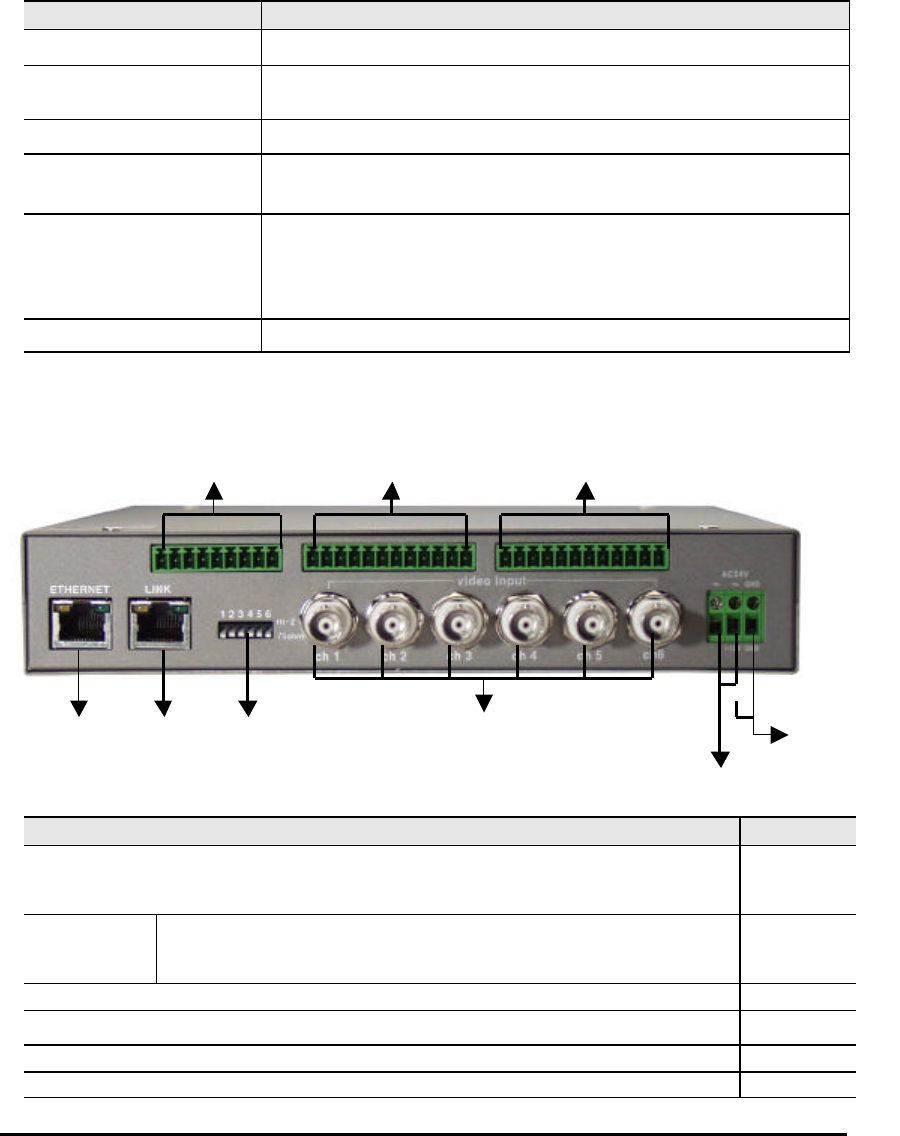
WebEye B106WebEye B106
User’s Guide
6
II. Product Description
1. WebEye B106
1) Contents
* Unpack and check all the items as below.
2) WebEye B106 View and Descriptions
Connector Name Description Remark
DIP switch To designate video signal termination of ‘Video
Input’ BNC connector
BNC
connector
CH1, CH2, CH3,
CH4, CH5, CH6 To input video signal through a coaxial cable
AC 24V To connect a power supply unit of 24V AC
DC 12V To connect a power supply unit of 12V DC
RJ-45 Ethernet port To connect 10 Base-T Ethernet cable
Link port Stackable up to three boxes only with one IP
Item Description Remarks
WebEye B106 Network server for CCTV camera
Manual WebEye B106 User's Guide
Quick reference guide
Provided on CD
Printed material
Crossover Cable 1 m crossover cable Red-colored
Direct Cable 2 m direct cable White-colored
Adapter & P ower Cable DC 12V, 1.0A
Accessories
19 inch-brackets for rack
Screw for bracket
Screw for rack
Plate
2
8
2
1
CD ROM title Setup program and manual
Network
Link
DIP Switch
Video Input
AC 24V
DC 12V
RS232/RS422/RS485
Sensor In
Alarm Out
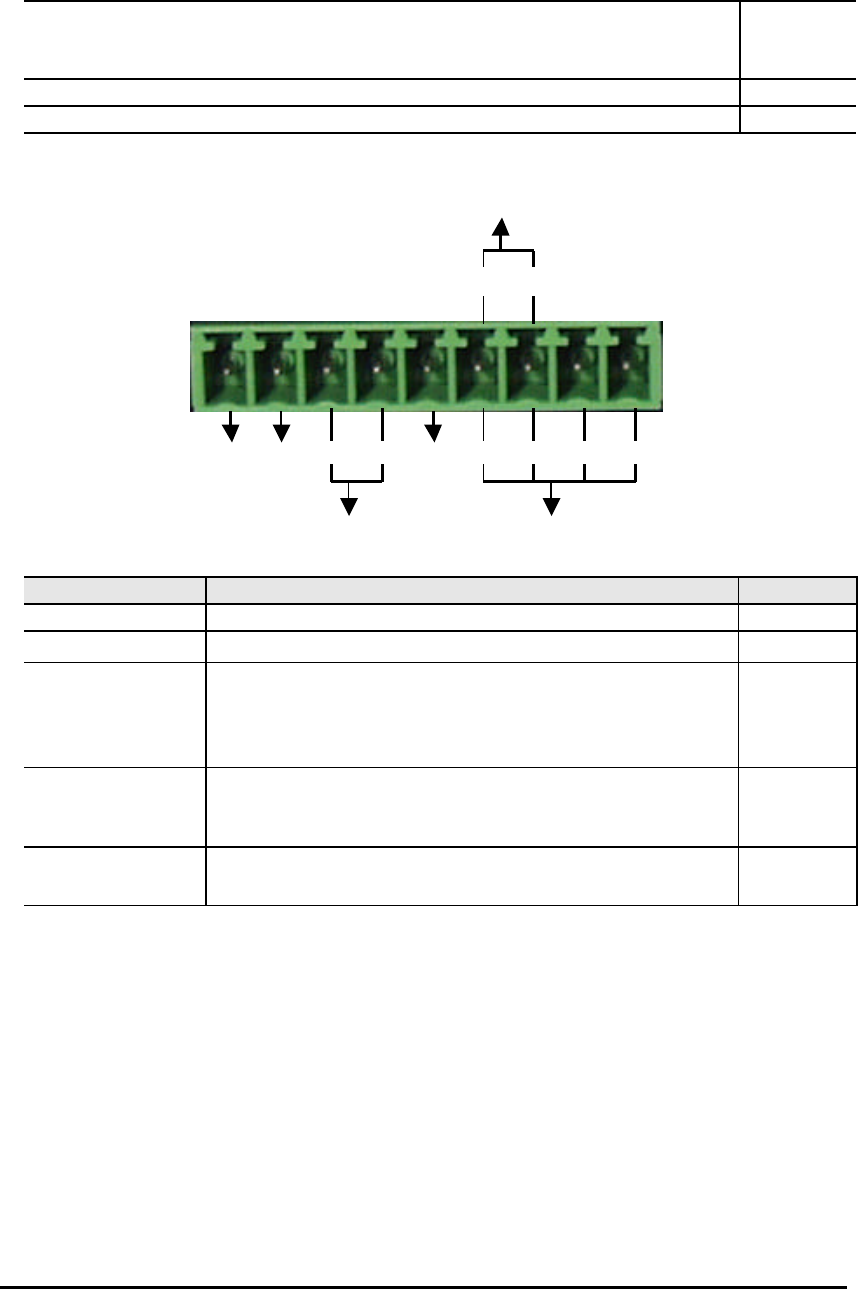
WebEye B106WebEye B106
User’s Guide
7
RS232/RS422/RS485 To communicate between external devices. These
pins are for devices that satisfy RS-232, RS422, or
RS485
Sensor In To input video signal through 6 coaxial cables
Alarm Out To output video signal through 6 coaxial cables
3) RS232/RS422/RS485 Descriptions
Connector Name Description Remark
Power To supply power to external devices
Ground To ground cables of power, communication, etc.
RS-232
To communicate between WebEye B106 and external devices
such a CCTV camera, WebEye A10 (An audio transmission kit),
or an external modem. These pins are for devices that satisfy
RS-232C protocol, and they are consisted in RX and TX.
RS-422
To communicate between WebEye B106 and a CCTV camera
that satisfies RS-422 protocol. They are half-duflex. It is
consisted in R+, R-, T+, and T-.
RS-485 To communicate between WebEye B106 and a CCTV camera
that satisfies RS-485 protocol. They are consisted in S+ and S-.
P
G
RS232
G
RS422
RS485
Rx
Tx
R+
R-
T+
T-
S+
S-

WebEye B106WebEye B106
User’s Guide
8
4) Description on LED of Ethernet Port
Yellow LED: This LED indicates the status of data transmission. After power is supplied, it is on for the first
4-5 seconds and then it goes off. And it blinks continuously when a user access WebEye and WebEye
transmits data.
Green LED : This LED indicates the status of networking. After power is supplied, it is on for the first 1-2
seconds, and then it blinks once at every one second as long as the network is connected.
5) Descriptions on DIP Switches
To configure the function of the six coaxial cable ports at the rear of WebEye B106.
You can configure the relevant channels with each switch.
If you connect two CCTV cameras to Video Inputs and monitor real time video through 1 and 2 channels,
place the two DIP switches (marked with No. 1 and 2) at upper position ‘ON ’ and the others at lower position
‘OFF’. If you connect six CCTV cameras to Video Inputs and monitor real time video through all channels,
place all of six DIP switches at upper position ‘ON ’.
12 3 4 5 ON
OFF
75 75 ΩΩ
DIP Switch
6

WebEye B106WebEye B106
User’s Guide
9
III. WebEye B106 Installation Summary, Connection & Placing
1. Installation Summary
l Connect Ethernet and Power to WebEye on local network for configuration.
l Install WebEye Setup Program into a PC on local network.
l Assign an IP address to WebEye and configure administrator’s condition.
l Configure user’s condition.
l Place WebEye, re-connect power and Ethernet.
2. Connecting
l Connect Ethernet line to the Ethernet port in the rear.
l Connect the power supply .
l Confirm that the LED of the Ethernet port blinks.
IV. Installing WebEye B106 Setup Program
l Insert the WebEye Setup disk.
l Drag the WebEye Setup icon onto the desktop.
l Double-click on the icon.
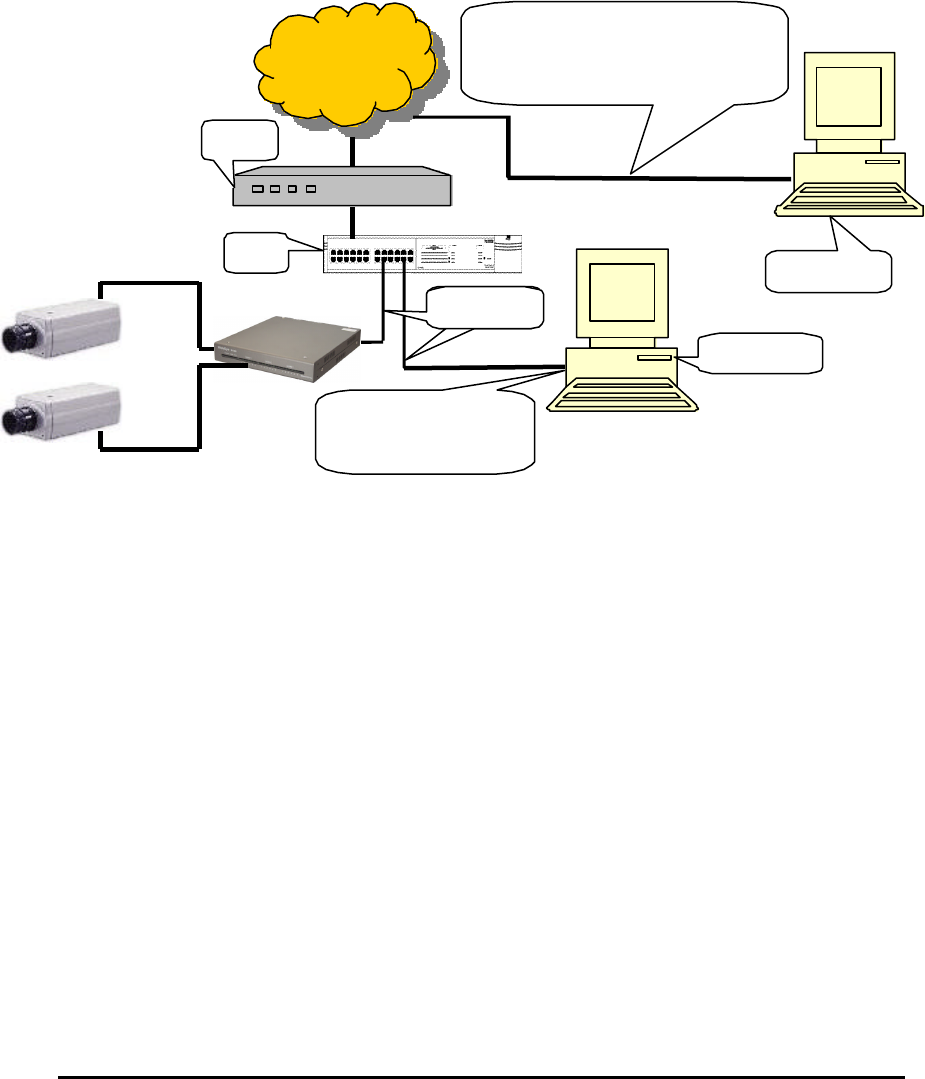
WebEye B106WebEye B106
User’s Guide
10
V. Assigning IP Address and Configuring Administrator’s Condition
1. Connecting WebEye B106 to a PC
1) Connecting WebEye B106 on Internet or LAN
Use the direct cable (white colored one) to connect WebEye B106 to Internet or LAN. With this connection,
remote users will not be able to access WebEye until local user configures WebEye’s network setting.
Connect WebEye to a
PC through a HUB.
HUB
Direct cable
Internet
Local User
Remote User
Router
Dedicated line, xDSL line, cable
modem line, ISDN line, and PSTN
(telephone) line are available.
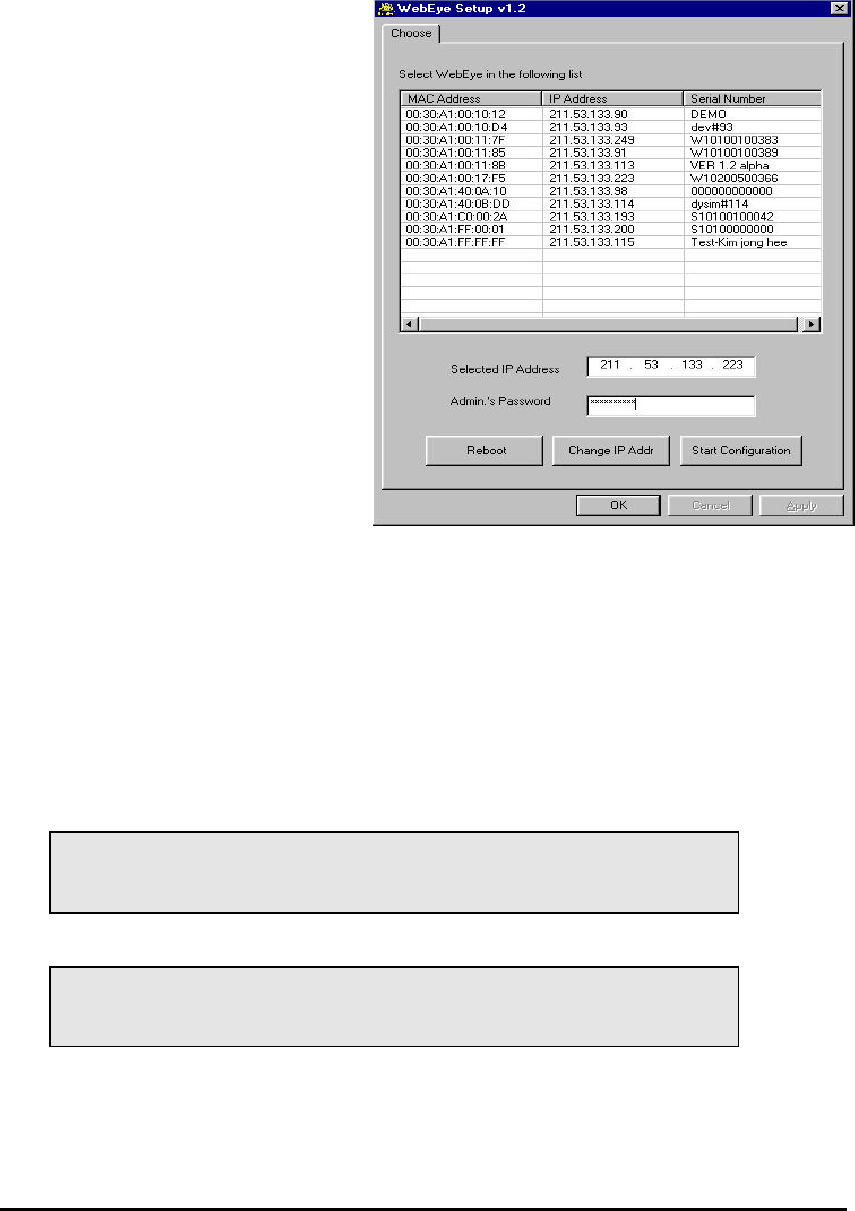
WebEye B106WebEye B106
User’s Guide
11
2. Assigning IP address and Configuring administrator’s condition with Setup program
1) Starting Setup Program for WebEye B106
Click the “WebEyeSetup.exe ” file on your
PC. When the Setup Program is executed,
the setup program detects and shows every
WebEye connected on the local network.
From the WebEyes listed, select one to
assign a new IP address. (Default is
211.53.133.92) To choose a WebEye, click
on its MAC Address or IP addres
When a WebEye is selected, its IP address
will appear in the ‘Selected IP Address’ box.
Type a password in the “Admin’s
Password” box to change the IP address,
reboot WebEye, or start configuration.
The default password is “admin”.
To change the IP address, enter the Admin’s
password and click “Change IP Addr.”
Enter the new IP address and click “OK.”
2) Configuring Administrator’s Conditions
To access the WebEye’s Administrator’s Page from the Setup Menu, enter the admin.’s password and click
the “Start Confi guration” button. (For more detailed information, refer to Chapter VII “Configuring
Administrator’s Condition at Homepage”)
3. Assigning IP Address with ARP command
1) Using ARP in Windows 98 and NT
When using WebEye with Windows 98 and Windows NT, follow the steps below.
• Open a DOS window and type the following commands.
arp -s <WebEye IP address> <WebEye Ethernet address>
ping -t <WebEye IP address>
• Example
arp -s 192 .168.1.3 00-40-8c-10-00-86
ping -t 192.168.1.3
2) Verifying Installation
After successfully completing the above procedures, the following message (or similar) will appear on the
screen:

WebEye B106WebEye B106
User’s Guide
12
Request timed out
:
Request timed out
Reply from 200.243.232.178: bytes=32 time=2ms TTL=255
Reply from 200.243.232.178: bytes=32 time=2ms TTL=255
Ping statistics for 200.243.232.178:
Packets: Sent = 4, Received = 4, Lost = 0 (0% loss),
Approximate round trip times in milliseconds:
Minimum = 1ms, Maximum = 2ms, Average = 1ms
If the above “ping” reply does not appear, press 'F3' and 'Enter' keys. Normally “Request timed out”
messages appear 7 times before replying properly.
Once the above “ping” reply appears press <Ctrl>+<C> keys to make it stop.
When the “ping” replies stops, data loss may range from 0% to 99%. This is normal. If the statistic shows
‘100% loss’, check the following criterions: (a) network line and connection status are stable; (b) IP address
assigned to WebEye is available; (c) PC and WebEye have the same local network IP address. Same local IP
address of C grade network means that first 3 sets of numbers are the same but the fourth set is different. For
example 192.168.1.2 and 192.168.1.3 are in the same local network. (If there is a ‘Network Mask ’ on the
network, this can be an exception. For detailed information on IP, refer to appendix 4)

WebEye B106WebEye B106
User’s Guide
13
VI. Accessing WebEye B106 Homepage & Monitoring Real-time Image
After assigning WebEye an IP address, the WebEye can be configured within its self- contained homepage
through any standard Web browser on a local network.
1. Starting Web browser
Start the web browser and enter the WebEye IP address. This will access the WebEye login homepage.
2. Login page
1) ID and password
The login page allows only registered WebEye users to view images from WebEye. To connect to WebEye
and view real-time images, follow the login procedures.
The default name and password for the user is “guest.” The default Admin username and password is
“admin .” Both may be changed at the Admin page, but neither the ID nor password can be more than nine
characters long.
2) Behind Firewall
If the PC is connected on a network where firewall is, real time image will not be viewed properly because
video TCP port of WebEye is blocked.
To connect Server Push Viewer directly at WebEye homepage, click on ‘Behind Firewall’ menu.
3) WebEye Plug-in for Netscape user
To monitor real-time images using Netscape Navigator, the WebEye Plug-in program is needed. This can be
downloaded from the login page by clicking “Download WebEye Plug In Now!”. When connecting WebEye
for the first time or having Plug-in program of lower version, download it.
4) WebEye Active-X for MS Explorer User
Systems using Microsoft Explorer require Active-X Control program. The program will usually be installed
automatically when a user accesses a WebEye. A pop -up window will appear for Active-X installation, click
“yes.” If images still do not appear after installation, check the “c:\windows \download program files” folder
(for Windows 2000 NT, the directory is c: \WINNT\download program files).
5) WebEye Java Applet for Macintosh or Unix system User
Java Applet viewer is for systems that do not use MS Windows. Macintosh OS or Unix can be used with the
Java Applet viewer. Java Applet viewer requires java virtual machine that should already be installed on
user’s computer.
6) FAQ
Frequently asked questions and answers are provided here for troubleshooting. If user has other questions,
please contact WebGate Inc. through http://www.webgateinc.com
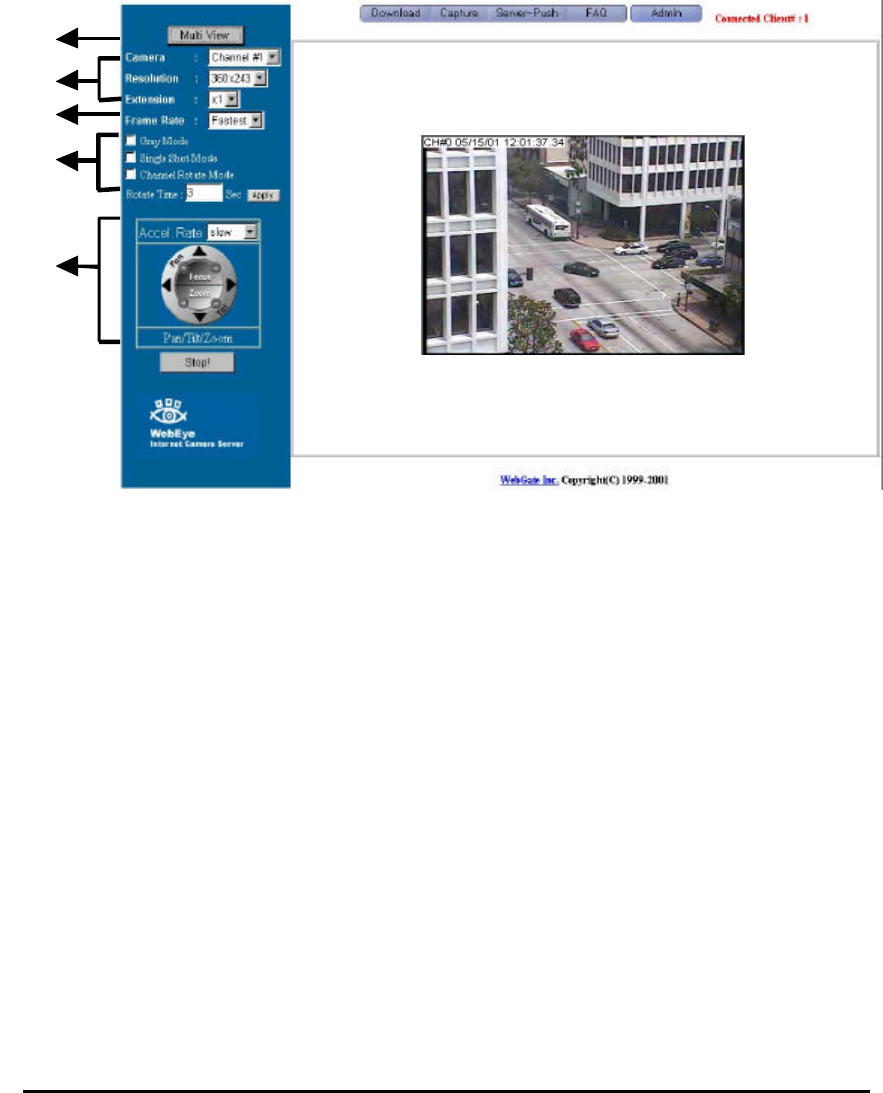
WebEye B106WebEye B106
User’s Guide
14
3. Various viewers in WebEye homepage
There are 3 viewers for real-time monitoring in the WebEye homepage: Default Viewer, Server-Push Viewer,
and Java Applet Viewer. An administrator may set 3 different viewers as main viewer. (Default Simple
Viewer, Default Multi Viewer, and Server Push Viewer)
1) Real time monitoring through Default Single Viewer
At default viewer, a user may configure image transmission method and control integrated PTZ mechanism of
a CCTV camera. The PTZ control panel is activated in some seconds depending on network speed.
(1) Single View / Multi View
The “Multi View” allows the monitoring of other images from additional cameras connected to the WebEye.
If you can press the “Multi View”, you can view six images simultaneously . Please note that transmission
speed cannot exceed 30 fps, and additional images will make overall transmission speed slow. “Single View”
monitors a single channel.
(2) Image Control
Resolution
Select the level of resolution from 5 levels (720x486, 720x243, 360x243, 180x121, 90x60). High er-resolution
image s are larger file sizes and are transmitted at slower speed.
Expansion
Expansion enlarges the image from 1X to 4X. However, expansion (2X to 4X) does not increase image’s
resolution, hence the clarity of an expanded image will not be as good as the original.
Frame rate
To control image transmission speed. “F astest,” will receive images at the fastest speed possible within the
network environment. The transmission speed is dependent on the network line’s capacity and user PC’s
(1)
(2)
(3)
(4)
(5)

WebEye B106WebEye B106
User’s Guide
15
performance. WebEye can transmit up to 30 frames per second, but total frames transmitted by all 6 channels
cannot surpass the maximum rate of 30 fps.
(3) Camera selection
Select cameras to monitor. User may select one specific camera or all 6 cameras.
(4) Transmission Control
Gray Mode On
Images are disp layed in black and white. Images can be transmitted at a higher speed under gray mode.
Single Shot ModeOn
When this button is clicked, one frame of image is reproduced. Therefore, no other image s may be viewed.
Channel Rotate Mode On
Images are viewed one after another as channel number. It may be configured by second.
(5) Play Control
Pan/Tilt
To move the direction of external camera to where to want to see.
Zoom
To zoom the image in and out.
Focus
To control and optimize the image ’s focus.
Accel. Rate
To control the moving speed of the Pan / Tilt mechanism. There are three settings, denoted by the small
graphic located between the “+” and “—“ signs. “Accel.” does not control zooming speed. This can be
adjusted with the mouse.
Play/Stop: WebEye ge nerates and transfers the real-time images as soon as it is accessed. To stop transferring
images, click the “Stop ” button. To resume transfer, click “Play” button .
(6) Other Function Buttons
Download
To download updated versions of Netscape Plug-in program for WebEye.
Capture
To save a frame of still image transmitted from WebEye. A still image can be saved as a format of bitmap
(*.bmp) or Wavelet method file (*.eye). Wavelet compression image file can be decompressed and
reproduced on Internet browsers such as Netscape or Explorer.
Server-Push
To go to the server-push viewer.
FAQ
It lists frequently asked questions and answers.

WebEye B106WebEye B106
User’s Guide
16
Admin
To access administration page . (Refer to Chapter VII ‘Configuring Administrator’s Configuration at
Homepage’)
(7) Co nvenient pop-up menu
A small window of 5 menus appears when you click the right button of the mouse. However only users who
are permitted can utilize the functions such as ‘Quality Box’, ‘Focus Sensitivity’, and ‘Image Quality’. ‘Image
Info’ and ‘Save File As ’ menus are permitted to any user. And the results of the four functions except ‘Save
As File’ are to be affected in every image that is transmitted to all users. (For detailed information, refer to
‘User account management ’ in Chapter VII). And in server push viewer, only ‘Image Info’ and ‘Save As File’
menus are supported.
Image Info
You may decide the color (black or white) of the information that is shown on the left top of the image. And
you may leave out the information.
Quality Box
This is to set a certain area clear and remained area dull. You can overcome insufficient network bandwidth
with this function, because the file size is reduced with unfocused area. Quality Box is to be set like under
written description.
• Choose ‘New QBOX’ button.
• Place mouse cursor on a certain point of real time image where to start QBOX.
• Click and drag the mouse point.
Focus sensitivity
You may configure movement degree of zoom mechanism. The sensitivity is from Level 0 to Level 9. By
selecting ‘Level 9’, user zooms in or out at the largest degree. A user who has ‘PTZ control ’ right may utilize
this menu.
Image quality
It is to set image quality. The image quality is from Level 0 to 9. If user chooses the ‘Level 9’, WebEye sends
the finest image. However, transmission frame rate will be reduced because of large sized data. If user
chooses ‘Level 0’, WebEye sends dullest image but fast. A user who has ‘Video control’ right may utilize this
menu.
Save File As
It is to save a frame of still image as an electric file. A still image can be saved as bitmap (*.bmp) file or
Wavelet format file (*.eye). Wavelet formatted image file is to be reproduced on Internet browsers such as
Internet Explorer or Netscape Navigator as long as the PC is installed Active-X or Plug-in program.
(8) Placing a company logo and hyper-linking
The WebGate company logo , located on the left bottom of the viewer, can be replaced with a different
company logo. This logo can then be used as a hyper-link to a company web page.
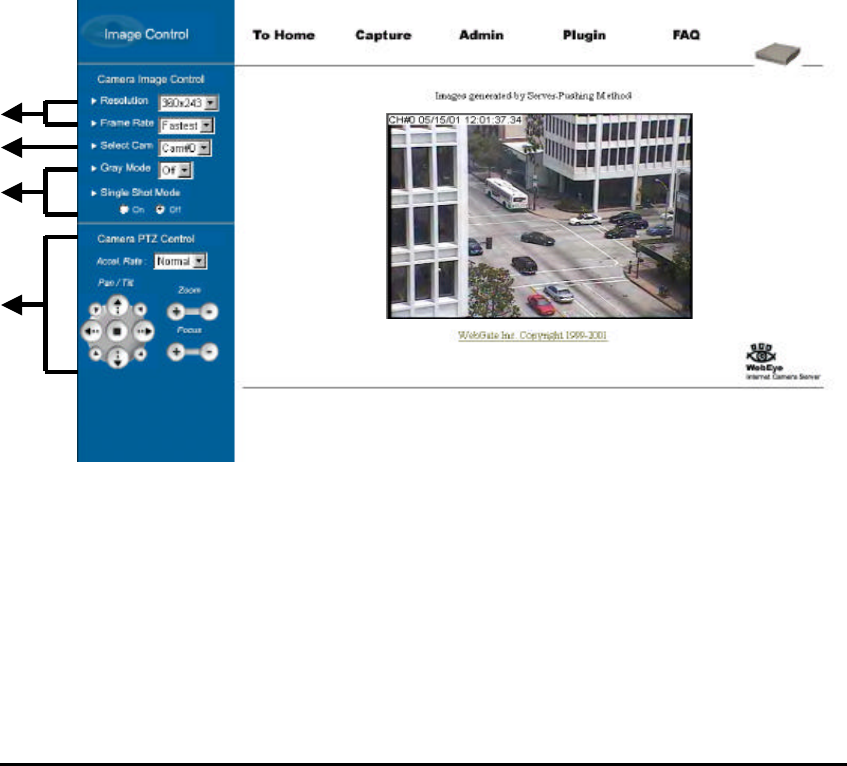
WebEye B106WebEye B106
User’s Guide
17
2) Real time monitoring through Default Multi Viewer
(1) Single View / Multi View
You can select a mode between single view and multi view. The button is toggled between the two functions.
(2) Play/Stop
WebEye generates and transfers six real-time images as soon as it is accessed. To stop transferring images,
click the “Stop ” button. To resume transfer, click “Play” button.
(3) Camera selection
Select the camera to configure a frame rate.
(4) Frame Rate
Control image transmission speed. “Fastest,” will receive images at the fastest speed possible within the
network environment. The transmission speed is dependent on the network line’s capacity and user PC’s
performance.
3) Real time monitoring through Server Push Viewer
If WebEye is installed on a network where firewall is, you may access WebEye through server-push viewer
to monitor real -time images.
(1) Image Control
‘Progressive Mode’ image transmission menu is not supported.
Resolution
Select the level of resolution from 5 levels (720x486, 720x243, 360x243, 180x121, 90x60).
Higher-resolution images are larger file sizes and are transmitted at slower speed.
Frame Rate
Control image transmission speed from 5 levels (fastest, 10fps, 5fps, 3fps, 1fps). “F astest,” will receive
images at the fastest speed possible within the network environment.
(1)
(2)
(3)
(4)

WebEye B106WebEye B106
User’s Guide
18
(2) Camera
Select cameras to monitor. User may select one specific camera to monitor real-time image.
(3) Transmission Control
On this viewer, “Progressive Mode” and “Channel Rotate Mode On” menus are not available.
Gray Mode
Images are displayed in black and white. Images can be transmitted at a higher speed under gray mode.
Single Shot Mode
When this button is clicked, one frame of image is reproduced. Therefore, no other image s may be viewed.
(4) Play Control
Pan/Tilt: To move the direction of external camera to where to want to see.
Zoom: To zoom the image in and out.
Focus : To control and optimize the image ’s focus.
Accel . Rate: To control the moving speed of the Pan / Tilt mechanism.
(5) Convenient pop-up menu
‘Quality Box’, ‘Focus Sensitivity’, and ‘Image Quality’ menus are not supported.
Image Info
You may decide the color (black or white) of the information that is shown on the left top of the image.
Save File As
It is to save a frame of still image as an electric file. A still image can be saved as bitmap (*.bmp) file or
Wavelet format file (*.eye).
(6) To Home
This button returns to the default viewer.
(7) Capture
This button is to save a frame of still image transmitted from WebEye. This function is the same with ‘Save
File As’ menu.
(8) Admin
It is to access administration page . (Refer to Chapter VII ‘Configuring Administrator’s Configuration at
Homepage’)
(9) Plug-in
Click on the “Plugin” link to download the latest version of the Netscape WebEye Plug-in. This is only
necessary for t hose who use Netscape Navigator.
(10) FAQ
User may refer FAQ for trouble-shooting in installing or running WebEye.
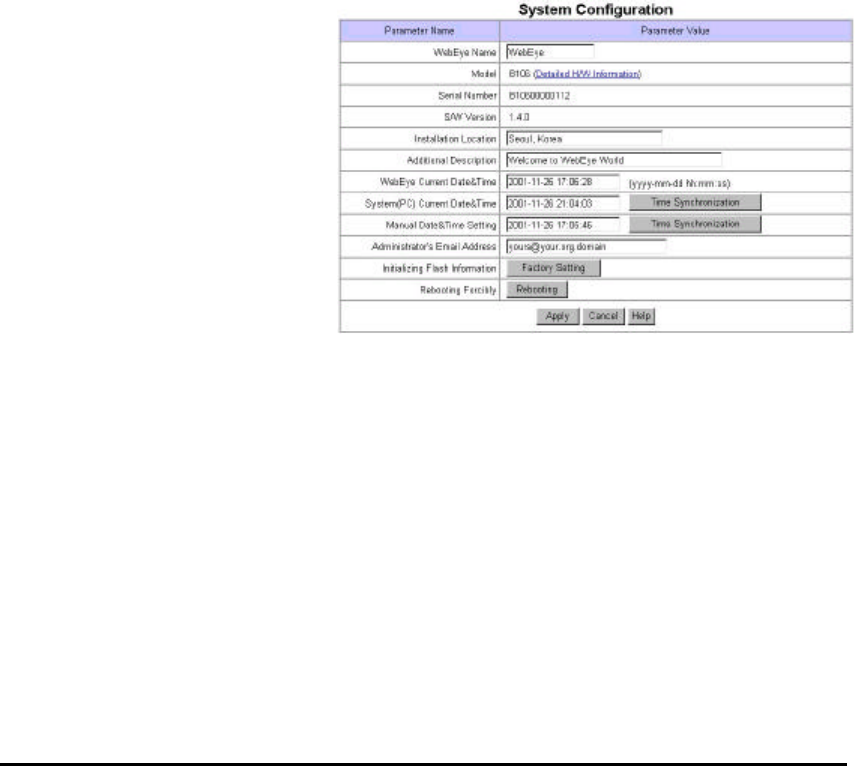
WebEye B106WebEye B106
User’s Guide
19
VII. Configuring Administrator’s Condition at WebEye B106 Homepage
This page is for administrator. Administrator may control operating status remotely. This page can be
accessed through Setup program by clicking ‘Start Configuration’ button.
1. Administrator Login
1) Accessing through setup program
Select WebEye by clicking on the MAC address or IP address. Then type in the administrator ’s ID and
password (Default ID and password are ‘admin’), and click “Start Configuration” button. The setup program
automatically connects to the Admin page of WebEye Homepage.
2) Accessing through Web browser
On Web browser, a user may access WebEye login page with its IP address. In the login page, a user may key
in administrator’s ID and password or a normal user’s ID and password. With any of ID and password, the
user may access real time image viewer page.
2. Configuring Administrator’s Condition at Homepage
1) System Configuration
This page is to set name, date & time,
location, and description of one’s
WebEye. Model, serial number, and
software version appear automatically.
(1) WebEye Name
The name is to be used to register the
WebEye on a certain server, if dynamic
IP address is used. Therefore it is very
important to set a proper name for user
to find the WebEye in the dynamic IP
registration list. (For detailed
information, refer to ‘Dynamic IP
Registration Service for ISDN, xDSL User’)
(2) Model
By clicking ‘Detailed H/W Information’, administrator may view the detailed hardware information such as
maximum numbers of channel, serial port, digital input, digital output, etc. The model name is marked
automatically.
(3) Installation Location & Additional Description
The information is to show in the real time image viewer page as well as in a dynamic IP registration list.
(4) Date & Time
There are three date & time menus. In “WebEye Current Date & Time” panel, the date and time that is set in
the WebEye appears. In “System (PC) Current Date & Time” panel, the same date and time that is set in
user’s PC appears.
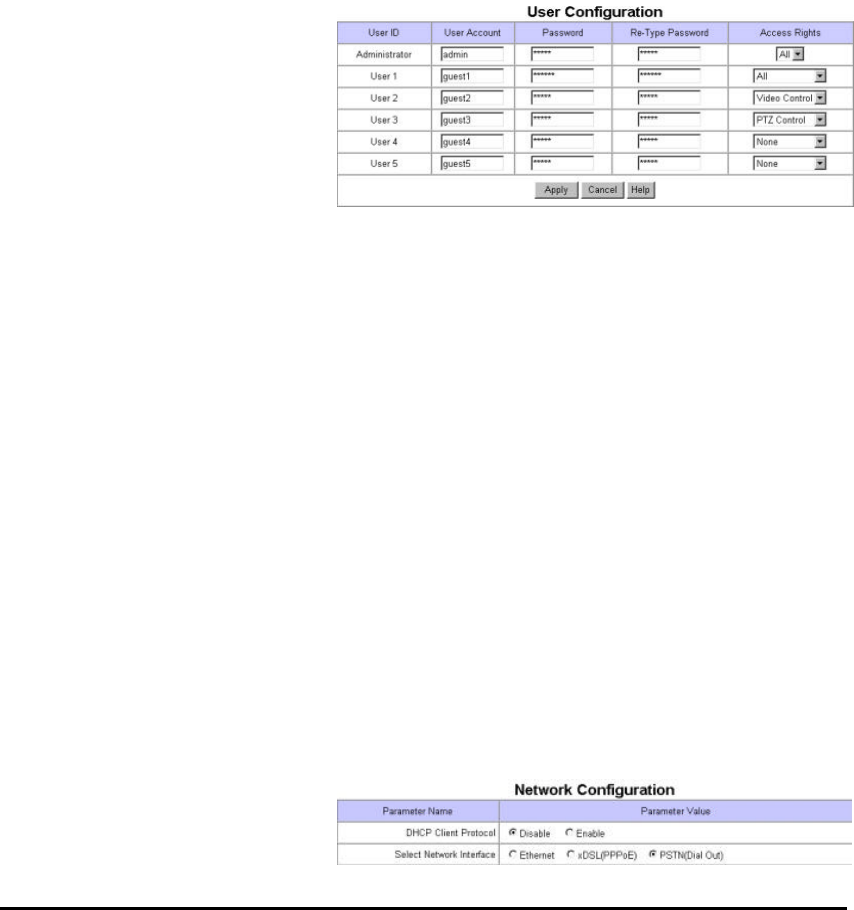
WebEye B106WebEye B106
User’s Guide
20
(5) Administrator’s E-mail Address
In this panel, administrator records one’s e-mail address. If administrator put a ‘contact’ menu of e-mail
communication on real time image viewer page, the linked e-mail address to the ‘contact’ menu is to be
synchronized with this.
(6) Initialize Flash Info
This will initialize almost all the information saved on Flash Memory. However Date & Time, Model, Serial
Number, and IP configuration of “System Configuration”, and Video Signal Type of “Video Configuration”
menus will not be changed.
(7) Rebooting
If WebEye has any problems, administrator can reboot it without adjusting power supply. This button works
as on/off switch.
2) User Configuration
This page is to configure IDs and
passwords of an administrator and 5
users.
(1) User Account
There are one administrator ’s account
and 5 users’ accounts. Account name
can be changed.
(2) Password
If you want to open your WebEye to everyone, you may not change default user’s ID and password. However
you should change administrator’s ID and password as unique ones.
(3) Access Rights
Administrator may give or take users’ right of PTZ control and video control. With default setting,
administrator has both right of PTZ control and video control and normal user doesn’t have any right.
• Video control : This is to control pop-up menus such as image quality level and QBOX settings.
• PTZ control: This is to control ‘Focus Sensitivity’ in pop-up menu and to control PTZ mechanism of a
CCTV camera.
3) Network Configuration
This page is to define network type and set network addresses of WebEye.
(1) DHCP Client Protocol
DHCP (Dynamic Host Configuration Protocol) is to manage host address on a network. With this protocol,
every host on a LAN may share limited official IP address for Internet access. In other words, every host on a
LAN may lease official IP address from DHCP server temporarily.
(2) Select Network Interface
This is to select proper network
interface with which WebEye is
connected. If WebEye is connected with
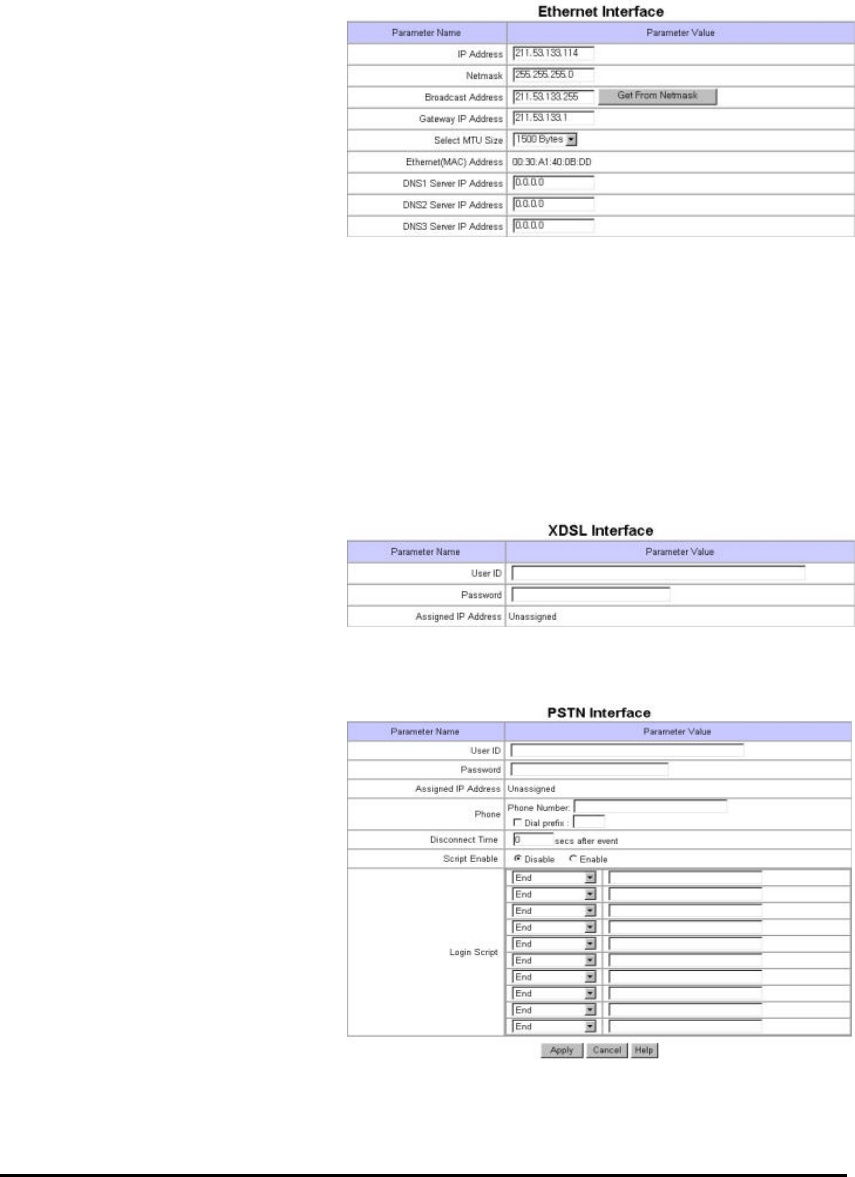
WebEye B106WebEye B106
User’s Guide
21
Internet dedicated line, cable modem line or on LAN environment, you should select network interface as
‘Ethernet’. If WebEye is connected on xDSL line that needs PPPoE process to connect on Internet,
administrator should select ‘xDSL (PPPoE)’.
(3) Ethernet Interface
Administrator may configure IP address,
subnet mask, broadcast address, gateway
address, and DNS addresses of WebEye.
For broadcast address, administrator may
set it automatically by clicking ‘Get From
Netmask’ button after assigning IP
address and subnet mask.
This interface is mainly used for Internet
dedicated line and LAN, and sometimes for xDSL line as it is explained on ‘DHCP Client Protocol’ setting.
MTU Size: Depending on network type, administrator may set data packet size with this menu to utilize the
network at most effectively.
DNS Server IP Address: This is used when you register your WebEye on dynamic IP registration list of
WRS (WebEye Registration Server). WRS has its domain name of ‘webeye.to’ and the domain name is
registered on DNS servers on the world.
(4) xDSL Interface
If WebEye is connected on xDSL line
and needs PPPoE process, administrator
should select network interface as ‘xDSL
(PPPoE)’. And administrator should
configure user ID and password for PPPoE. ID and password may be acquired from the ISP that installed the
line.
(5) PSTN Interface
If WebEye is to be connected on Internet
through PSTN (Public Sw itched
Telephone Network) based on PPP,
administrator should select network
interface as ‘PSTN (Dial-out)’. This
interface is for WebEye to connect to ISP
through telephone line for Internet
connection. In this case, WebEye is
connected to dial-up modem with a serial
cable unlike other interfaces such as
‘Ethernet’ or ‘xDSL (PPPoE) ’.
There are two methods for users to access
WebEye through PPP connection. And being seen from WebEye, one is that WebEye dials out and the other is
that WebEye is dialed in through dial-up modem.

WebEye B106WebEye B106
User’s Guide
22
Dial-out 1: It is for WebEye to make dial-up progress to connect to ISP for PPP connection. WebEye dials
up to ISP according to the event that is configured at administration page of ‘Application Configuration’.
After PPP connection is made, WebEye sends e-mail or file. The process is as follows.
• WebEye dials up to ISP to connect on Internet.
• ISP asks information for login such as ID, password, etc, and WebEye answers to corresponding
questions.
• ISP makes PPP connection to WebEye and assigns an IP (official dynamic/fixed IP) to WebEye.
• WebEye access Internet and send e-mail or file to pre-defined person or FTP server.
Dial-out 2: While WebEye makes PPP connection to send e-mail or file, administrator may open to
common users to access WebEye through Internet. For this purpose administrator should set WebEye to
register itself on WRS (WebEye Registration Server). For detailed information on WRS service, please
refer to ‘Dynamic IP Registration Service’ configuration page in this manual.
• WebEye dials up to ISP to connect on Internet.
• ISP asks information for login such as ID, password, etc, and WebEye answers to corresponding
questions.
• ISP makes PPP connection to WebEye and assigns an IP (official dynamic/fixed IP) to WebEye.
• WebEye connects to WRS (WebEye Registration Server) and list itself on the list. (More detailed
information on WRS, please refer to Dynamic IP Registration Service in this manual.)
• Users access Internet homepage of ‘WebEye Dynamic IP Registration Server’ (www.webeye.to) and
find out the WebEye in the list.
• Users access WebEye to monitor real-time image on Internet.
Dial-in: It is for a user to make PPP connection to WebEye with his PC that connects on Internet through
dial-up modem. Detailed process is as follows. With this connection, only one user can access WebEye at
the same time.
• A user dials up to the modem that is connected to WebEye.
• WebEye makes PPP connection to the user’s PC and assign an IP (private IP) to the PC. In this case,
WebEye assigns an IP address that is in the same local network compared to its own IP address.
• Users access WebEye homepage through web browser by entering WebEye’s IP address to monitor
real-time image.
Below items especially user ID, password, and phone number are used for WebEye to connect ISP based on
standard PPP.
ID/Password: It is to put proper user ID and password for connecting to ISP.
Phone: It is to put telephone number of ISP. If a prefix needs in dialing (e.g. 9), you should mark tick on the
menu and put the prefix the following square.
Disconnect Time : WebEye maintains connection for some while there is action such as sending e-mail or
files. And when the action is stopped, WebEye disconnects after sometime. This is to configure how long
WebEye maintains the connection after any action doesn’t occur.
Login Script: If your telephone line needs special login script to connect ISP, you should enable ‘Script
Enable’ menu and describe the login script. At the section, there are some commands to describe script.
- End: To end the login process.
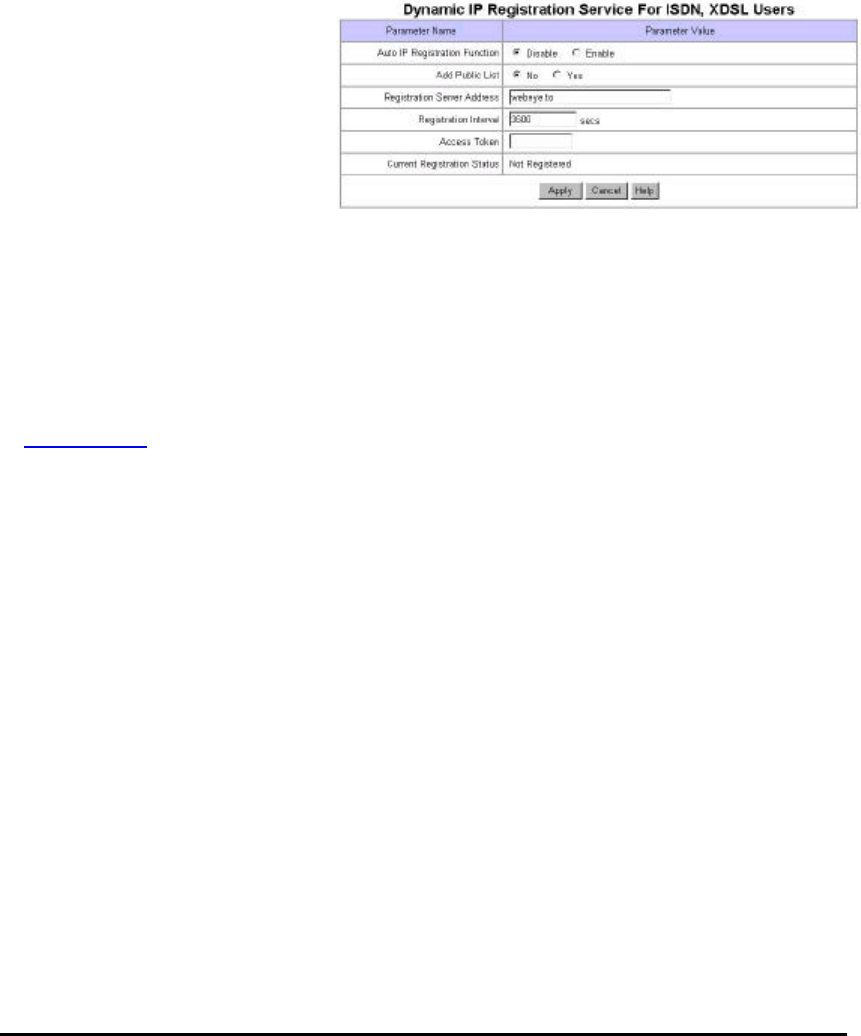
WebEye B106WebEye B106
User’s Guide
23
- Wait for: To wait for a certain signal.
- Wait for Prompt: To wait for prompt.
- Send: To send after described script.
- Send CR (Carriage Return): It has the same effect to press ‘Enter’ key in the script.
- Send User ID: To send the ID that is described in ‘User ID’ square.
- Send Password: To send the password that is described in ‘Password’ square.
- Delay: To delay for a certain seconds that is described the following square.
4) Dynamic IP registration service for ISDN and xDSL users
This page is to register WebEye on
dynamic IP registration server.
If WebEye is installed on a network of
dynamic IP address (floating IP
address), administrator should register
the WebEye on dynamic IP registration
server to give common users simple
connectivity. If not, no one can access
the WebEye through Web browser. It is because that no one knows IP address which one can access the
WebEye with.
To solve the problem, WebGate runs a server making a list of WebEyes that have dynamic IP addresses. On
the server, WebEye registers its information such as name, location, and description, so that common users
may detect a certain WebEye. Name, location and description are assigned at ‘System Configuration’ page. If
administrator does not change them, the WebEye will register default information on the list, and it will be
very difficult to point out and access a certain WebEye. The list is on an Internet homepage of WebEye
(www.webeye.to).
(1) Auto IP Registration Function
Administrator may register one’s WebEye by enabling ‘Auto IP Registration Function’. Registration process
is that WebEye detects IP addresses from DHCP server and informs the detected IP addresses to dynamic IP
registration server.
(2) Registration Server Address
This is to configure a server address for registration. The registration server to be used for Dynamic IP
registration should be installed proper S/W, developed by WebGate Inc.
(3) Registration Interval
Dynamic IP address es are commonly used with xDSL, ISDN or Cable Modem lines. In order to maintain
continuous connectivity, user should reset the ‘Registration Interval’ at a shorter time interval than the default
value.
(4) Add Public List
There are two registration systems. One is to register on a public list and the other is on a private list.
(5) Access Token
Access token is a password and it is used when you register your own WebEye on a list ‘User’s WebEye’ out
of all WebEyes on WRS(WebEye Registration Server).
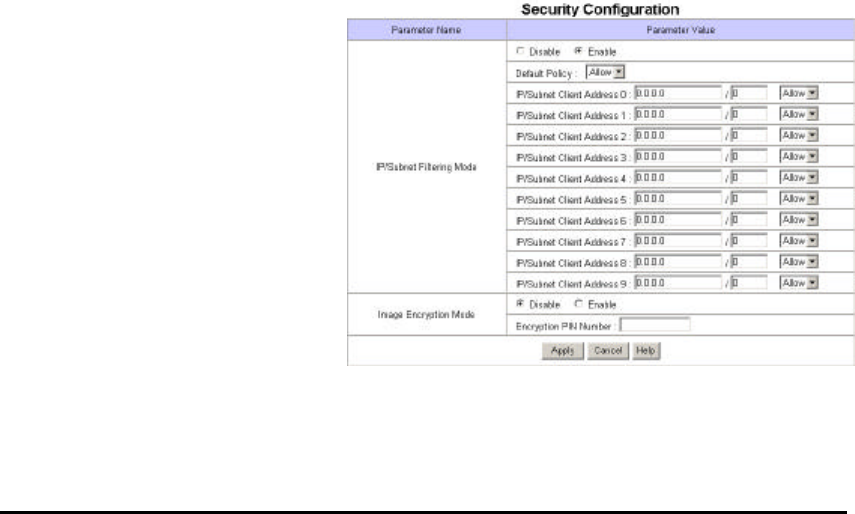
WebEye B106WebEye B106
User’s Guide
24
5) How to find a registered WebEye in WebEye Internet homepage
On WebGate Internet homepage (http://www.webgateinc.co.kr), there are menus to find WebEye that is
registered on WRS (WebEye Registration Server).
(1) Sign up membership
To search your WebEye out o f a public list or a private list, sign up membership first. You may sign up on the
server through ‘Membership’ menu.
(2) Finding WebEye from public list
To access WebEye that is registered on public list, you may find it through ‘WebEye Service’ or ‘Public
WebEye List’ menus. Once click ‘WebEye Service’ or ‘Public WebEye List’ menu, you may find ‘WebEye
list of WRS (WebEye Registration Server)’.
(3) Finding WebEye from private list
To access WebEye that is registered on private list, you should make your own WebEye list before. You may
make the list through ‘Searching WebEye’ menu of ‘WebEye Service’.
My WebEye List: You may maintain your own WebEye registering it on this list. When you login this
homepage, WRS (WebEye Registration Server) detects and shows all the WebEyes that you listed appear on
your own list.
Search and Append: This menu is to append a certain WebEye on your own list. You may append WebEye
on your own list as follows.
• Key in serial number (W100000000000), MAC address (e.g. 00:00:00:00:00:00), and access token of a
certain WebEye in the box.
• Click ‘Append’ menu.
• WRS (WebEye Registration Server) search a corresponding WebEye with the conditions from both the
‘Public List’ and ‘Private List’ and registers the WebEye on your own list.
6) Security Configuration
This is to filter a certain IP addresses
from accessing WebEye based on
network masking.
(1) IP/Subnet Filtering Mode
You may allow or deny a certain user to
access your WebEye with enabling this
menu.
Default Policy
This is to decide the principle of
‘IP/Subnet Filtering Mode’ between
allow and deny.
How to register allowed/denied user in the list
Network masking is to mask network ID for every existing IP address in the world. Therefore the IP addresses
that have the same network ID are to be applied with a command of ‘Allow’ or ‘Deny’. The masked bits are

WebEye B106WebEye B106
User’s Guide
25
considered as network ID.
Note: To explain and understand easily on IP address, the first byte of IP address is marked as X1 in this
manual. And X2 is for the second byte, X3 is for the third byte, and X4 is for the fourth byte.
IP address is constructed as follows.
IP address construction in binary number of each bit
xxxxxxxx (8 bit): X1 xxxxxxxx (8 bit): X2 xxxxxxxx (8 bit): X3 xxxxxxxx (8 bit): X4
27 26 25 24 23
22
2
1 2
0 27 26 25 24 23
22
2
1 2
0 27 26 25 24 23
22
2
1 2
0 2
7 26 25 24 23
22
21
20
E.g. IP address in binary: 11000000. 10101000. 00000001. 00001101 (It is equal to 192.168.1.13)
* Binary number 1 means to take the equivalent decimal number (2
7, 25, etc) and 0 means to disregard it.
IP address construction in decimal number of each byte
xxx (0 -255: 1 byte): X1 xxx (0 -255: 1 byte): X2 Xxx (0-255: 1 byte): X3 Xxx (0-255: 1 byte): X4
128
64
32
16
8 4 2 1 128
64
32
16
8 4 2 1 128
64
32
16
8 4 2 1 128
64 32
1
6
8 4 2 1
E.g. IP address in decimal: 192. 168. 1. 13 (It is equal to 11000000. 10101000. 00000001. 00001101)
* Binary number 1 means to take the equivalent decimal number (2
7, 25, etc) and 0 means to disregard it.
Network masking point is to be expressed with decimal number from 0 to 31. IP address is consisted in 4
bytes. 4 bytes are 32 bits. Network is to be masked on every bit from the first bit to the 32nd bit. Masked bit is
marked with binary number ‘1’, and the corresponding bits out of provided IP address are defined as network
ID for IP filtering.
Network masking point (0 to 31)
1 2 3 4 5 6 7 8 9 10 11
12 13
14 15 16 17 18 19 20 21
22
23 24 25 26
27 28 29 30
31 0
E.g. Network masking on the 8th bit (8): 11111111. 0000000. 00000000. 00000000 (255.0.0.0)
E.g. Network masking on the 16
th
bit (16): 11111111. 11111111. 00000000. 00000000 (255.255.0.0)
E.g. Network masking on the 24
th
bit (24): 11111111. 11111111. 11111111. 00000000 (255.255.255.0)
E.g. Network masking on the 32
nd
bit (0): 11111111. 11111111. 11111111. 11111111 (255.255.255.255)
According to masking point, masked network ID is to be different out of the same IP address. For example, if
IP address is described as 192.168.1.13 (11000000.10101000.00000001.00001101) with masking point 24
(255.255.255.0), the IP addresses whose IP address is consisted with
‘11000000.10101000.00000001.xxxxxxxx’ (28 (256) pieces of IP addresses) will be allowed or denied from
WebEye.
If you describe an IP address as 192.168.1.13 and put masking point 26 (255.255.255.192), the masked bits
are the first 26 digits and network ID masked as ‘11000000.10101000.00000001.00’. In this case, the IP
addresses whose IP address is consisted with ‘11000000.10101000.00000001.00xxxxxx’ (2 6 (64) pieces of IP
addresses) will be applied with a command of ‘Allow’ or ‘Deny’.
Applied IP address number according to masking point
1 2 3 4 5 6 7 8 9 10
11 12 13 14 15 16 17 18
19
20 21 22 23
24 25 26
27
28
29 30
31 0
231 230 229 228
227 2
26
2
25 2
24
223 222
221 220 219 218 2
17 2
16 215 214
213
212 211 210 2
9 2
8 27 26 25 24
23
22
2
1 2
0
E.g. Masking point 8: 224 pieces of IP addresses are applied
E.g. Masking point 16: 216 pieces of IP addresses are applied
E.g. Masking point 24: 28 pieces of IP addresses are applied
E.g. Masking point 0: 20 pieces of IP address (itself) is applied

WebEye B106WebEye B106
User’s Guide
26
Though masking point is to be any bit out of 32 bits, it is common to point on the bits of host ID part. If the
masking point is placed on network ID part, the range is expanded compared to the provided IP address.
Network class is divided as follows. D and E class networks are not to be used by normal user.
Class Decimal number of X1 byte Network ID Host ID
A 0 to 127 X1 X2, X3, X4
B 128 to 191 X1, X2 X3, X4
C 192 to 223 X1, X2, X3 X4
D 224 to 239 For Multicasting utilization
E 240 to 255 Reserved for specific utilization
In C class network, the applied number of IP addresses with network masking is as below when you mask on
host ID part (X4: the fourth byte).
Masking on X4 Byte Remark Host ID
number
25 26 27 28 29 30 31 0 Masking Point
128
(128)
64
(192)
32
(224)
16
(240)
8
(248)
4
(252)
2
(254)
1
(255)
Decimal Number
(Accumulated Value)
Masked Free Free Free Free Free Free Free 7 digits are free 27 = 128
Masked Free Free Free Free Free Free 6 digits are free 26 = 64
Masked Free Free Free Free Free 5 digits are free 25 = 32
Masked Free Free Free Free 4 digits are free 24 = 16
Masked Free Free Free 3 digits are free 23 = 8
Masked Free Free 2 digits are free 22 = 4
Masked Free 1 digi ts are free 21 = 2
Masked No free digit 20 = 1
The most common case is to make subnet through network masking, and it is to divide a network into some
smaller network. If provided IP address is 192.168.1.2, you may divide the whole network into 2 sub-networks
and allow or deny only the IP addresses that belong to one of sub-networks.
With setting as follows, The IP address of 192.168.1.2 is divided into two sub-networks and allow for the IP
address out of the first sub-network to assess WebEye.
• Default Policy: Deny
• IP address: 192.168.1.2
• Masking: 25 (255.255.255.128)
• Then only the IP addresses from 192.168.1.0 to 192.168.1.127 are to access WebEye, while the IP
addresses from 192.168.1.128 to 192.168.1.255 and any other IP address are to be denied accessing
WebEye.
Changing IP address can reverse the result. If you set IP address as 192.168.1.130, only the IP addresses from
192.168.1.128 to 192.168.1.255 are to access WebEye. And the IP addresses from 192.168.1.0 to
192.168.1.127 and any other IP address are to be denied accessing WebEye. You may refer below table to
figure out masking point from network information that is given from your ISP or network administrator.
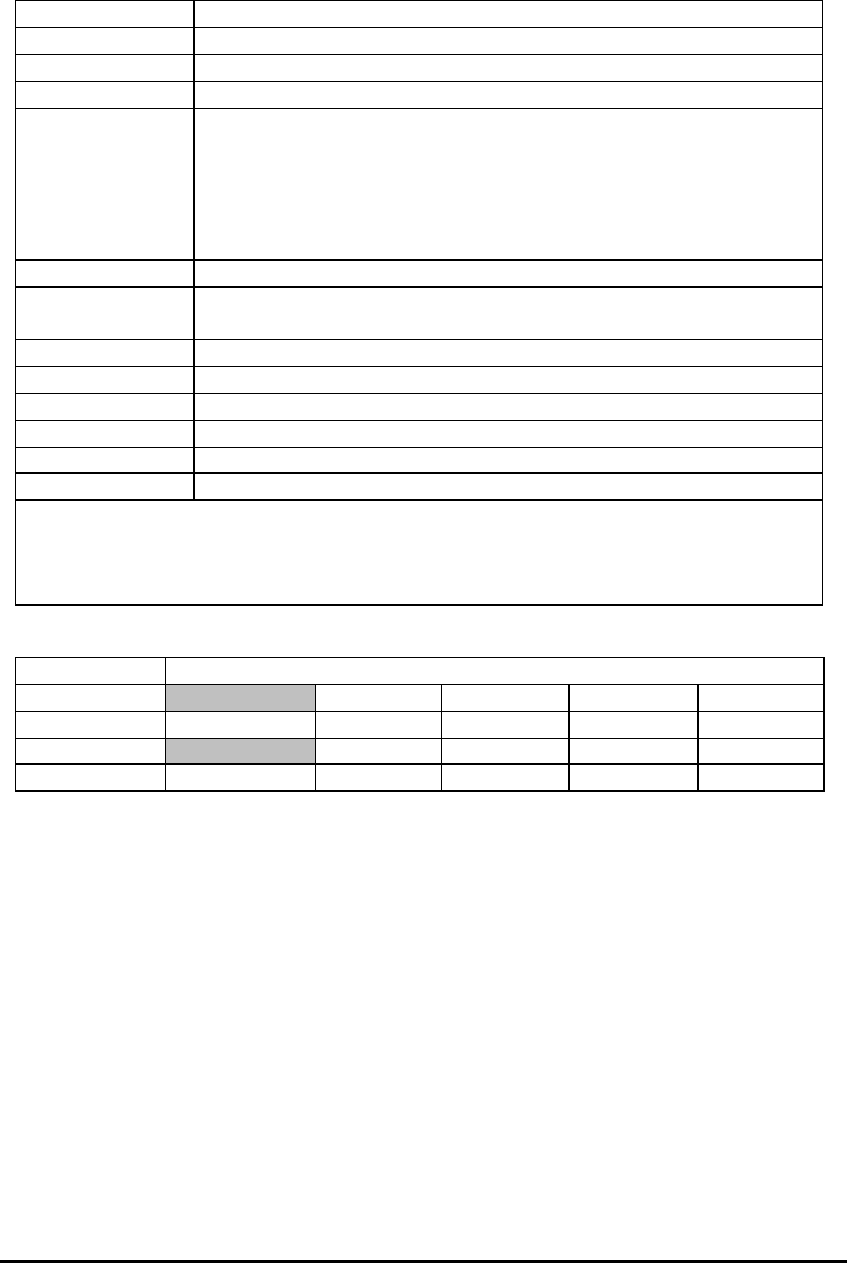
WebEye B106WebEye B106
User’s Guide
27
Masking Point Masked bit (Network ID) Netmask in decimal number
1 The first bit 128.0.0.0
2 From the first bit to the second bit 192.0.0.0
3 From the first bit to the third bit 224.0.0.0
.
8
9
.
16
17
.
.
From the first bit to the 8th bit
From the first bit to the 9th bit
.
From the first bit to the 16th
bit
From the first bit to the 17th
bit
.
.
255.0.0.0
255.128.0.0
.
255.255.0.0
255.255.128.0
.
24 From the first bit to the 24th
bit 255.255.255.0
25 From the first bit to the 25th
bit 255.255.255.128
26 From the first bit to the 26th
bit 255.255.255.192
27 From the first bit to t he 27th
bit 255.255.255.224
28 From the first bit to the 28th
bit 255.255.255.240
29 From the first bit to the 29th
bit 255.255.255.248
30 From the first bit to the 30th
bit 255.255.255.252
31 From the first bit to the 31st
bit 255.255.255.254
0 The 32nd bit 255.255.255.255
* Masking on 32nd bit has the same effect as masking none, and in WebEye 0 instead of 32 is used.
Masking 32 bits means that all the 32 bits are network ID, and masking none means that all the 32 bits
are host ID. Therefore masking all the 32 bits or none means that the provided IP address itself is applied
with a command of ‘Allow’ or ‘Deny’.
If you want to allow only the IP addresses from 192.168.1.61 to 192.168.70, you may set as bellows.
Default Policy Deny
IP address 192.168.1.60 Masking 30 Policy Allow
IP address 192.168.1.60 Masking 0 Policy Deny
IP address 192.168.1.64 Masking 29 Policy Allow
IP address 192.168.1.71 Masking 0 Policy Deny
* The IP addresses in black squares can be any IP address of the sub-networks. In the first square,
192.168.1.60 to 192.168.1.63 is to be assigned. And in the second square 192.168.1.64 to 192.168.1.71 is to
be assigned.
(2) Image Encryption Mode
Administrator may restrict people to receive images from one’s WebEye, even though people accessed it. If
‘Image Encryption Mode’ is enabled and a pin number is assigned, people have to key in the assigned pin
number to see image after accessing WebEye image viewers.
‘Security Configuration’ is a double-checking function to control accessibility, utilizing ‘User Account
Configuration’ at the same time.
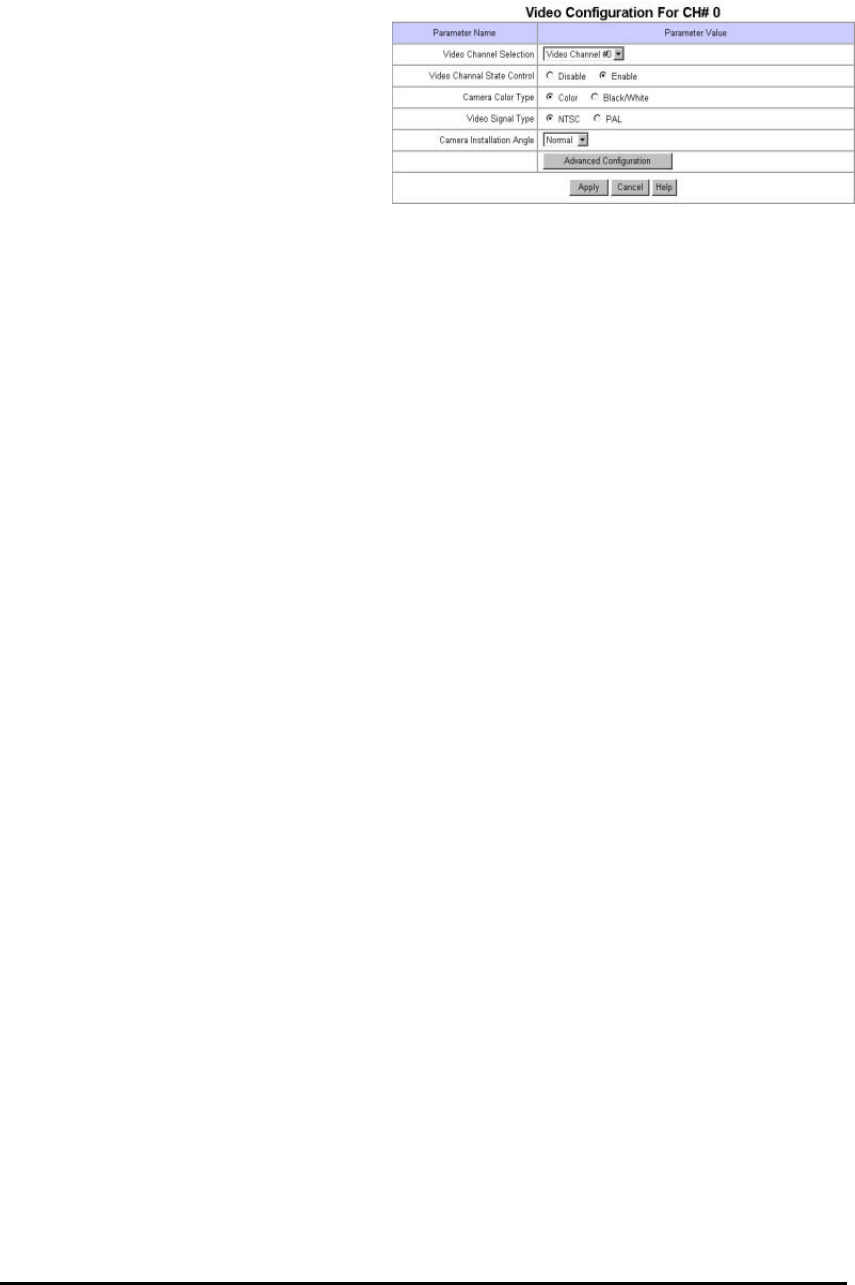
WebEye B106WebEye B106
User’s Guide
28
7) Video Configuration
This page is to configure every channel with
various conditions.
(1) Video Channel Selection
To select which video channel to configure. In
the list, there are 6 video channels.
(2) Video Channel State Control
It is to determine which channels will be enabled to send image signals to the image viewer. If a channel with
an external source is disabled, no image will appear in the image viewer. However, if a channel without an
external source is enabled, the overall transmission speed will go down and no image will appear. To view an
image from an external source, the channel with the source must be enabled.
(3) Camera Color Type
It is to define whether images from a camera are color or Black/White (B/W). This will not change a camera’s
original character (color cameras can be viewed in B/W or color, but they are still “color” cameras). Rather,
this is to help define external cameras, and provide information to WebEye.
(4) Video Signal Type
It is to define whether the signals of external CCTV cameras are ‘NTSC ’ or ‘PAL’.
(5) Camera Installation Angle
WebEye can always show images in right angle regardless of camera’s installation position. If camera is
located on the wall upside down, user can adjust image angel by selecting ’90 deg.’ or ‘270 deg. ’
(6) Advanced Configuration
Calibration Parameters
Administrator can manipulate screen settings by adjusting brightness, contrast, hue, saturation, horizontal line
shift, and vertical line shift from the menu. With ‘Video Gain’ menu, the image may be optimized without
adjusting each value of other menus. However ‘Video Gain’ is not supported currently. It is to be supported in
near future.
Caption Display Options
Administrator can configure caption on real time image with display options such as color and contents.
Caption is to be made of time information, channel information, and additional explanation (user defined
string).
Visual Setting Parameters
Administrator can configure QBOX and image quality level with aid of real time image. Place the mouse
curse on real time image and click the right button, and pop-up menus will be viewed.
• QBOX Parameters : Administrator sets QBOX area with a mouse to ‘click and drag’. Selected area
shows in ‘Left Top Placement’ and ‘Right Bottom Placement’ panels in figures. With ‘Ambient Level’
menu, Administrator may set quality level of unfocused area in the image (out of the focused range).
• Image Quality Level: Administrator chooses image quality level from 0 to 9. Level 9 is the best quality.
But transmission speed will be reduced because of larger sized data. The image level inside the
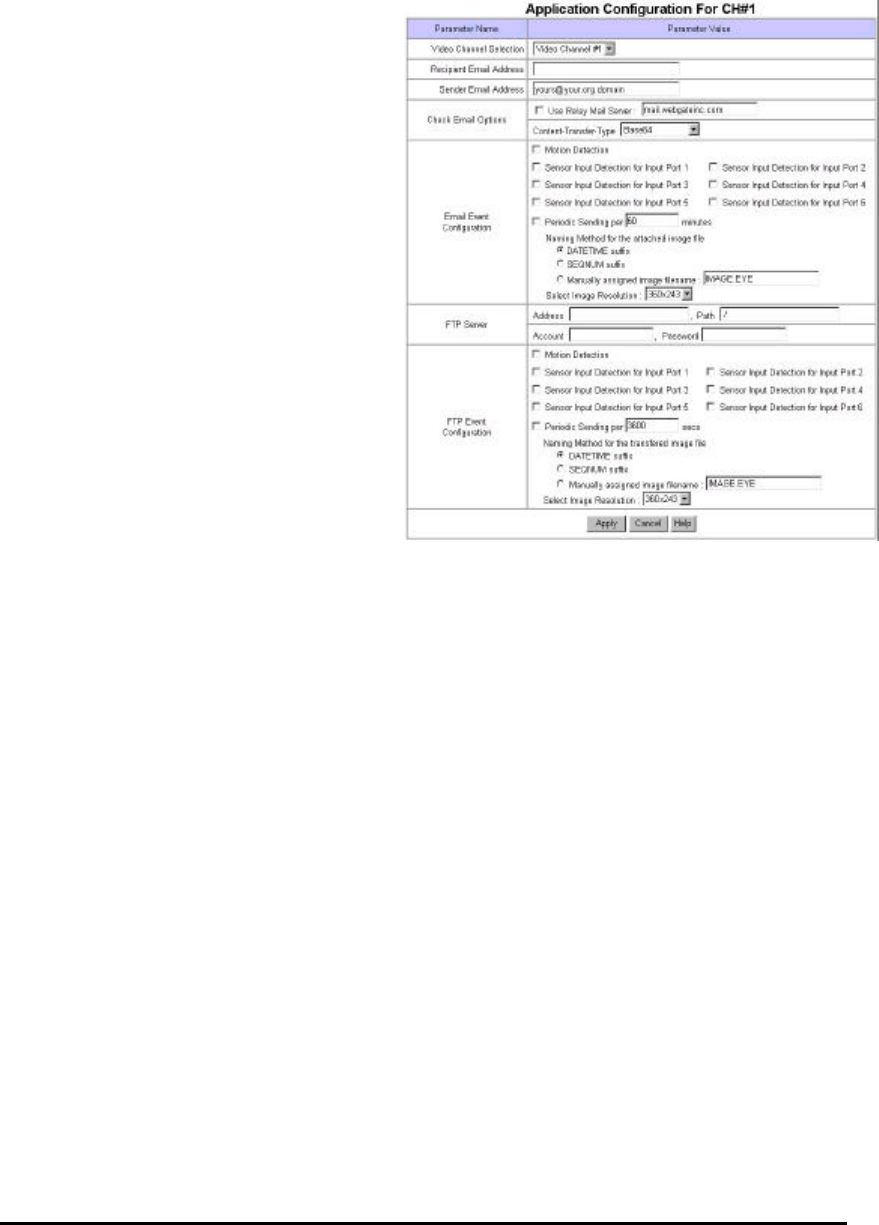
WebEye B106WebEye B106
User’s Guide
29
‘QBOX ’ is the same level as is selected in this menu.
8) Application Configuration
This page is to configure e-mail and file sending
functions.
(1) Select Video Channel
It is to select a video channel for configuration.
(2) Recipient E-mail Address
This is to designate a person to receive E-mail.
(3) Sender’s E-mail Address
This is to put a person ’s e-mail address that is
considered as the e-mail sender.
The e-mail sender can be a person who should
take care of the situation when events occur.
E-mail will be delivered to a person who is
defined as a recipient in the blank of ‘E-Mail
Recipient ’. The person who received e-mail can
send a message of countermove to a person who
is defined as an e-mail sender.
(4) Check E-Mail Options
Relay Mail Server: With the same problem of e-mail blocking, WebEye has a function to relay its e-mail
through an available e-mail server so that e-mail can have the relay server’s domain name. After activating
‘User Relay Mail Server’ menu, key in a server’s domain name such as ‘@abcdefg.com’.
Content-Transfer-Type: It is to define e-mail format. E-mail servers support ‘Base64’ format in common,
but some servers not. In the case, select the format as ‘Quoted Printable’.
(5) E-Mail Event Configuration
Event source: Administrator should define the triggering event for E-mail delivery among MD (motion
detection), sensor 1, sensor 2, sensor 3, sensor 4, sensor 5, and sensor 6. If administrator clicks on sensor1,
e-mail is sent when the sensor1 detects events.
File name : Administrator can name the image files by one of three methods: date & time (DATETIME; e.g.
IMG-CH00 -2001030-223031.eye), serial number (SEQNUM; e.g. IMG-CH00 -SN1.eye), or the administrator
can name the file (Manually assigned filename). The image file has the extension “.eye” to enable
reproduction on an Internet browser.
Image quality: Administrator may set image ’s resolution that is delivered by e-mail. Resolution is to be set
among 90x60, 180x121, 360x243, 720x243, and 720x486. An image of 90 by 60 is of the lowest resolution
and the smallest size.
(6) FTP directory configuration
Administrator assigns FTP server address, FTP user account, FTP user password, and FTP user path to
receive files when events occur.
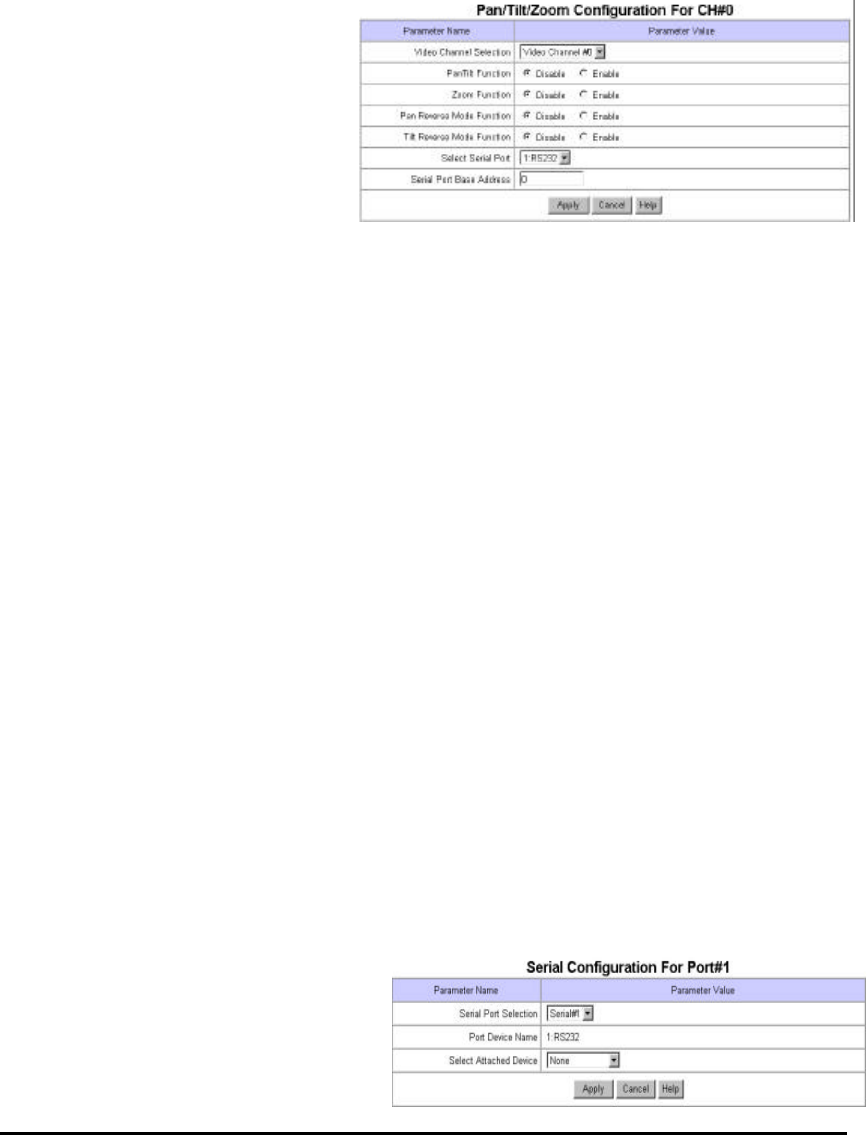
WebEye B106WebEye B106
User’s Guide
30
(7) FTP event configuration
Administrator may set sending conditions, image resolution, and file name. Image resolution, filename, and
sending conditions setting methods for FTP are same as that of e-mail.
9) Pan/Tilt/Zoom Configuration
This page is to decide whether to use
pan/tilt/zoom control function or not and
select which serial port to use.
(1) Video Channel Selection
Administrator selects a video channel for
the pan/tilt/zoom mechanism. The four
channels shown in the panel are the same
as seen on ‘Video Configuration’ page.
(2) Pan Tilt Function
Administrator defines whether to utilize pan/tilt control function or not.
(3) Zoom Function
Administrator defines whether to utilize zoom control function or not.
(4) Pan Reverse Mode Function
This is to set command reverse direction against to right and left direction control arrows. This function is
useful when PT driver is installed upside down.
(5) Tilt Reverse Mode Function
This is to set command reverse direction against to up and down direction control arrows. This function is
useful when PT driver is installed upside down.
(6) Select Serial Port
It is to select a useable serial p ort as the character of pan/tilt/zoom control receiver.
It is to select a serial port between ‘Serial #1’ and ‘Serial #2 ’ with which a pan/tilt/zoom control receiver is
connected to WebEye. Serial #1 is RS232C interface and Serial #2 is RS422/RS485 interface.
(7) Serial Port Base Address
This menu identifies the base address for a video channel and a pan/tilt/zoom (P/T/Z) control receiver.
WebEye B106 can support up to six P/T/Z devices for six separate channels when Serial #2 (RS485
Half-Duplex) is enabled. The “Serial Port Base Address” identifies each P/T/Z device to each channel. Select
a channel to configure and change the “Serial Port Base Address” to correspond with the channel number.
10) Serial Port Configuration
This page is to select a communication protocol
among listed ones or to set control parameters
manually for each serial port.
(1) Serial Port Selection

WebEye B106WebEye B106
User’s Guide
31
Administrator selects a serial port to configure. WebEye B106 has two serial ports. Serial #1 is a RS232C
interface port, and Serial #2 is a RS485/RS422 interface port.
(2) Select Attached Device
Administrator selects a communication protocol that an attached external device satisfies among already listed
protocols. WebGate has listed protocols of Philips, Pelco (P and D), Sensormatic, Video Technical (VTP 4x),
LG (GAC-PT2), Sony (EVI-D3x), Surveyor (PT360 and TransitRCM), Sungjin (SJ3728R1), Kukjae
(KRS-3200), Serim (SRP-PT1), Mitsubishi (CIT7300), and Samsung (SRX100B). Administrator may utilize
any pan/tilt mechanism that satisfies already listed protocols.
Audio Device
This protocol is for WebEye A10, which is an audio transmission device connected to WebEye. For more
detailed information on WebEye A10, please refer to WebEye A10 User’s Guide.
11) Digital I/O Configuration
This page is to configure digital input state and
control script. WebEye sends e-mails or/and files
when connected external sensors detect events.
(1) Input Port 1, 2, 3, 4, 5, and 6
Administrator defines active state of 6 digital
devices connected to six input ports such as
infrared sensors. If normal open type device is
connected to input port, select ‘NO (Normally
Open) ’. With normal close type device, select
‘NC (Normally Close)’.
(2) Output Port 1, 2, 3, 4, 5, and 6
WebEye shows current states of the 6 digital
devices connected to 6 output ports. In the status
panel, active state or de-active state message
shows. ‘De-Active State’ means that connected
device didn’t detect any event when ‘Apply ’ button is clicked. Though this message is not updated until
‘Apply’ button is clicked again, WebEye keeps on receiving status information from the connected device.
12) Alarm Configuration
This page is to set image- recording conditions
during an event situation for e-mail/FTP
delivered images.
(1) Motion Detection Threshold
Administrator sets the threshold for motion
detection function. Threshold ‘0’ is the most
sensitive state and ‘900’ is the least sensitive
state.
(2) Alarm Parameters for E-mail / FTP
Application

WebEye B106WebEye B106
User’s Guide
32
Administrator defines the image -recording conditions for an event, if WebEye detects events through motion
detection function (MD Event) or external devices (SID1, SID2, SID3, SID4, SID5 and SID6).
13) User Custom Configuration
This page is to customize TCP ports of data
transmission and default viewer composition.
(1) Web Server TCP Port
Administrator assigns a web server TCP port for
user access to WebEye and data transmission
from WebEye. 80th port is assigned as default
value.
(2) Video Server TCP Port
Administrator assigns a video server TCP port image transmission from WebEye. 8080th port is assigned as
default value.
(3) Select Main Page
Administrator assigns a viewer for the main page of WebEye. Three viewing options are available: “Default
Simple Viewer”, “Default Multi Viewer”, and “Server Push Viewer”. “Default Multi Viewer” displays
images through six-divided screens.
(4) Default Viewer Editing
‘Default Viewer’ is designed for users to edit easily. Editable parts are as bellows.
• Main Title: It is to change the main title displayed at the bottom of the default viewer.
• Logo Image Source URL: Administrator may assign the URL of any web site from which default
viewer gets a logo. The space to put a log is located on the left top of the viewer.
• Logo Image Link URL: Administrator may link the logo with a certain web page, such as a company or
personal homepage.
• Background Color & Foreground Color: Ground color of default viewer can be changed.
Administrator may set the color with RGB value.
14) Goto Viewer Page
This menu is to return to real time image viewer page from administration page.

WebEye B106WebEye B106
User’s Guide
33
(Appendix)
Detailed Specifications of WebEye B106
1. General
Hardware
CPU 32bit RISC Embedded processor
Flash memory 8MB
RAM 16M B
ROM 64KB
OS Embedded Linux
Video Channel NTSC or PAL video format are supported
6Ch. Internal Video Inputs
Image Resolution 720X486, 720X243, 360X243, 180X121, 90X60
Image Compression
Algorithm Wavelet
Rate 20:1 ~ 300:1
Performance
Transfer Rate Max. 120fps (With 3KB image)
Max. 30fps(NTSC) / 25 fps(PAL) (on 360X243)
Decoding Rate 2 ~ 30fps
Local Compression rate Max. 30fps/1Ch, 6fps/6Ch
Security Password Based User Authentication
IP-filtering (Secure Mode)
Image Encryption
Alarms and I/O Motion detection
Sends e-mail automatically
Sends the image files through FTP automatically
Software-controlled 6-alarm input
6 Digital Input (Coupler), 6 Digital Output (Relay)
MISC. function High quality image area setting
Image quality control (10 Levels)
Periodic sending of images through E-Mail or FTP
Gray/Progressive/Single-Shot/Channel Rotate Mode
User customized home page publishing supported by FTP
Audio supported through RS232 port
Power Supply DC 12V, 1.0A via external power supply
2. Network
Browser MS Internet Explorer V. 5.0 or higher
Netscape V. 4.7 or higher
JAVA Applet for non PC User (MAC or Unix)
Connector Two 10 Based-T Ethernet
(Network, Loop Stackable upto 3 boxes only with 1 IP)
Installation Assign IP address using setup program or ARP/RARP protocols
Protocols supported TCP/IP, HTTP, ARP, RARP, ICMP, DHCP, FTP, SMTP, PPP and PPPoE

WebEye B106WebEye B106
User’s Guide
34
S/W Upgrade Flash memory allows central remote software up grades over network
using FTP or private “WebyeUpgrade” program
Management Configuration is achieved by private setup program and Web server
built in administration page.
4. Mechanical
Dimension H x W x L = 40mm x 220mm x 240mm
Weight 1.25kg (without power supply)
5. Compatible external devices and software
PTZ control RS-232, RS485/RS422
Sensor input 6 auxiliary inputs are supported, made of ‘Opto coupler’
Op to coupler stands with 3-5V and 10-20mA